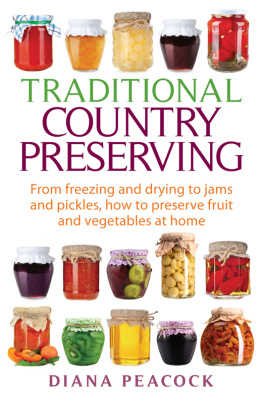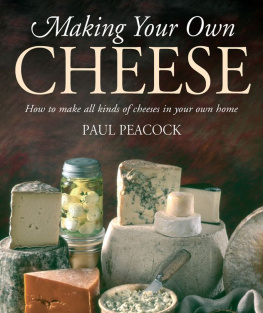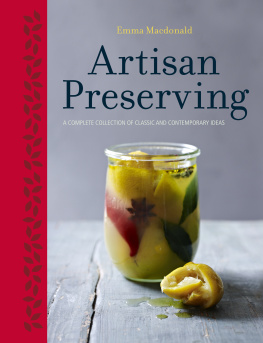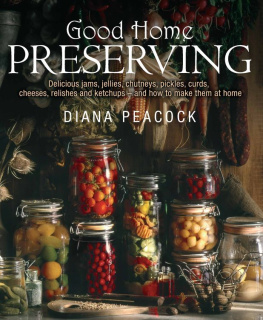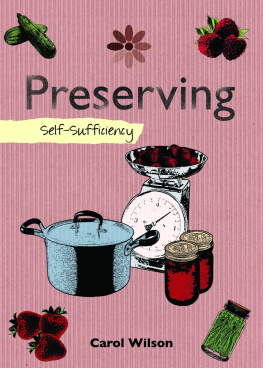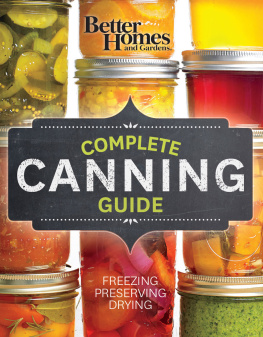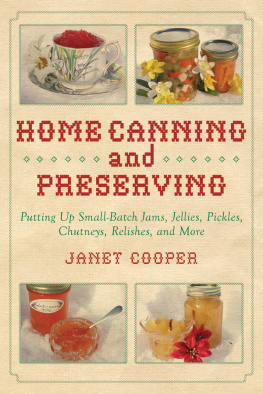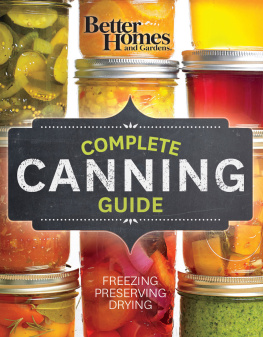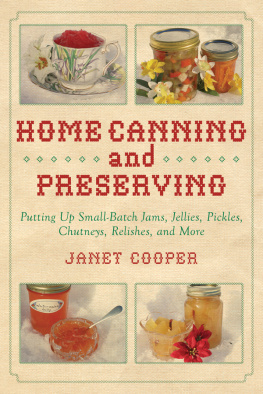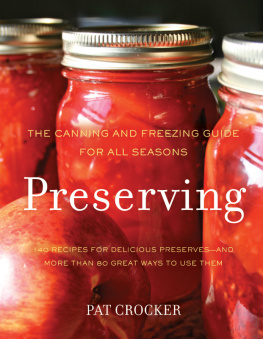Diana Peacock is an accomplished and experienced family cook, who practises self-sufficiency. She is the author of Good Home Baking, The Seasonal Cookbook, Grandmas Ways for Modern Days and How To Make Sweets and Treats.
Also available
The Wildlife Garden
Healthy Eating for Life
How to Make Wines at Home
Soups for Every Season
How to Make Jams, Pickles and Preserves
Afternoon Tea
Foolproof Cakes
TRADITIONAL COUNTRY PRESERVING
Diana Peacock

Constable & Robinson Ltd
55-56 Russell Square
London WC1B 4HP
www.constablerobinson.com
Originally published in the UK in 2010 as Good Home Preserving, by Spring Hill, an imprint of How To Books
This edition published in Great Britain in 2014 by Robinson
Copyright Diana Peacock 2010, 2014
The moral right of the author has been asserted.
All rights reserved.
No part of this publication may be reproduced, stored in a retrieval system, or transmitted, in any form, or by any means, without the prior permission in writing of the publisher, nor be otherwise circulated in any form of binding or cover other than that in which it is published and without a similar condition including this condition being imposed on the subsequent purchaser.
A CIP catalogue record for this book is available from the British Library.
ISBN 978-0-71602-371-5 (paperback)
ISBN 978-0-71602-378-4 (ebook)
Typeset in Great Britain by Ian Hughes www.mousematdesign.com
Printed and bound in the UK by CPI Mackays
Constable & Robinson Ltd.
5556 Russell Square
London WC1B 4HP
www.constablerobinson.com
An Hachette UK Company
www.hachette.co.uk
Contents
Introduction
The preservation of our food has been of the utmost importance to our survival for hundreds of years, to feed us through the bleak winter months in Great Britain. From freezing and drying to jams and pickling, all have helped keep food edible, when fresh has been scarce. Though we have shops well stocked with food and provisions that enable us not to have to worry about the shortages of winter time, when you grow your own fruit and vegetables for whatever reason, it is both sensible for the planet and your pocket to preserve the produce in the best possible way. Now we are able to freeze food effectively and reasonably economically it means we can have almost fresh-tasting fruit and vegetables all year round.
I find making my own jams and preserves both enjoyable and absorbing. Obviously it is very useful for using produce to its fullest and most productive, but it is also great fun.
Once you have mastered the art of making jams, chutneys and pickles, and it isnt difficult to do so, you can begin to experiment and make up your own recipes to suit your taste and whatever you may have a glut of at any one time.
Jams and other preserves make great presents and gifts at any time, but I have found them most welcome at Christmas when people are needing to entertain and tend to get through many preserves.
Never see preserving as a way to keep poor produce; it isnt worth it. All preserves need the best-quality fruit and vegetables; ripeness will be down to what is required for each individual type of preserve. For example, some jams are best prepared with under-ripe fruit, whereas the riper fruit is ideal for making jellies and syrups as the juice yield is higher.
Pride has always played an unashamed part in my preserve making, as I still get an inner glow when I say I made it myself, and hopefully you will get to feel this way about your own home-made preserves and thoroughly enjoy the process. It really is worthwhile.
1. Drying Fruit and Vegetables
Drying, along with salting, is one of the oldest known ways of preserving food. In hot climates it is also the most economical method. However, as we dont have a regular supply of sunshine available to us in Britain, it is better to dry produce indoors where a steady temperature can be maintained.
The two most important requirements for successful drying are a steady low temperature and ventilation. It is a lengthy process, but once the produce is ready to be dried it takes relatively little work to achieve a product that will keep for many months.
What do I need to dry my fruit and vegetables?
You can purchase electric drying machines that are economical to run and take all the worry out of the task. Depending on how much produce you wish to dry, you can choose from a range of prices from about 70 to 450. These machines come with full manufacturers instructions.
Alternatively, you can use a conventional oven. This method will need more attention, but you can still achieve good results so long as you follow simple rules.
Make sure your oven is available for many hours at a time as most foods take between 5 and 36 hours to dry out. They also require time to dry at room temperature before storing, so set aside a suitable space that is well ventilated and away from steam.
The temperature needed to dry produce depends on what and how large the items are, but generally it is between 100120C/gas mark 1.
Make a drying rack: take a cooling rack and stretch and secure a sheet of muslin over the top. The produce can be placed on top without touching to allow the warm air to pass around each piece.
Drying fruit
Stoned fruit plums, peaches and apricots are all suitable. Place whole fruit on the prepared tray and leave to dry for 2436 hours. Maintain the temperature until the skins have shrivelled. Leave for 12 hours in the air at room temperature to cool and allow any liquid to evaporate. Store in sterile jars.
Apples peel, core and slice into 5mm thick rings. Dip the rings in a bowl of lightly salted water and thread onto bamboo canes that will fit into your oven, resting on the side ledges. Leave the door of the oven slightly open. Drying should take about 5 hours, and then leave in the air for 12 hours before packing into sterile jars.
Drying vegetables
Peas and beans can be placed on the drying rack after blanching them for 4 minutes and drying them on a tea towel. They may be dried in the oven or in an airing cupboard. It will take about 4 hours for peas and 6 for beans. Leave them for 1 hour in the air before packing them into clean jars.
Mushrooms can be hung in a warm dry place for 34 days, where they will dry out quite successfully. Use freshly picked large flat or open-cupped mushrooms and remove the stalks. Wipe the mushrooms clean with a cloth, thread them onto a string using a thick poultry needle and tie a knot between each mushroom. Hang up the strings and leave to dry out. Store the mushrooms in jars in a dark cupboard. I use these in soups, curries or omelettes.
Tomatoes can be dried on the rack in a very cool oven for 35 hours depending on the size. Cutting the tomatoes in half shortens the drying time but I think it spoils the flavour slightly.
2. Freezing Fruit and Vegetables
This is probably the method that preserves the most natural flavour, colour and appearance of produce. It is certainly the quickest and easiest method, needing few if any other ingredients to prolong the life of fruit and vegetables.
Most vegetables may be frozen after a little preparation and can be packaged in such a way as to enable you to lift the portions you need from the freezer at any one time. However, salad vegetables, such as lettuce and cucumbers, are unsuitable for freezing due to their high water content; once defrosted they would end up a mushy mess.
Next page
